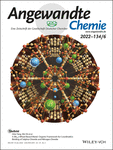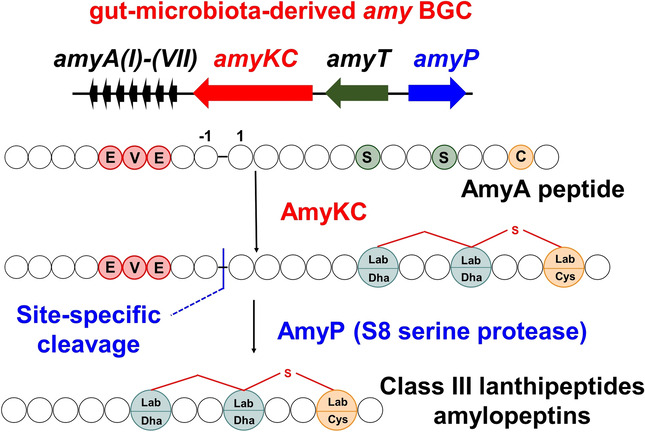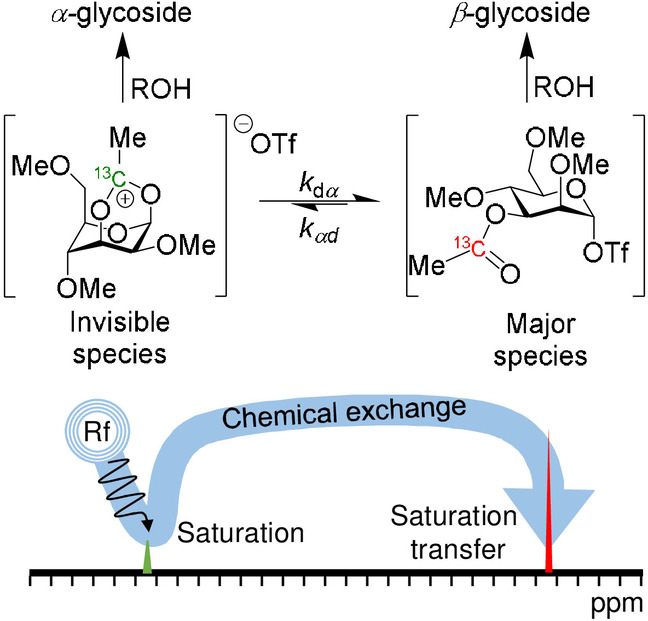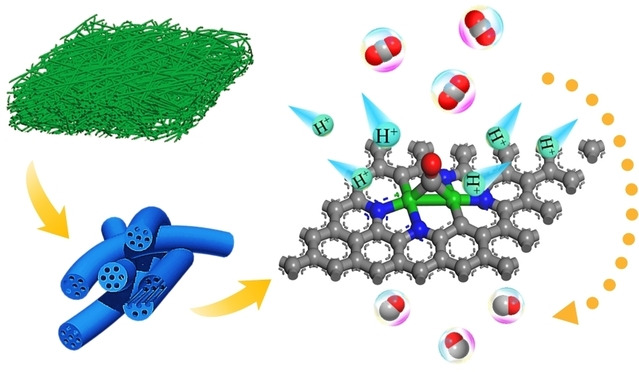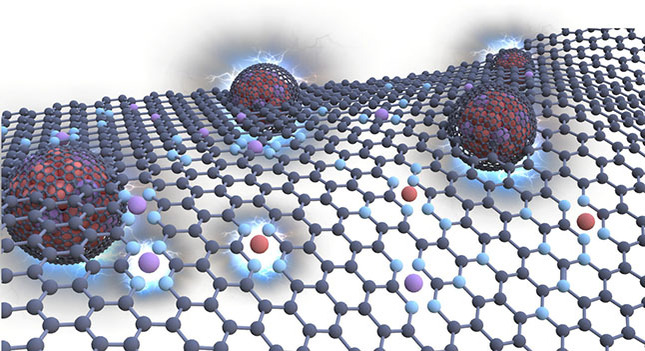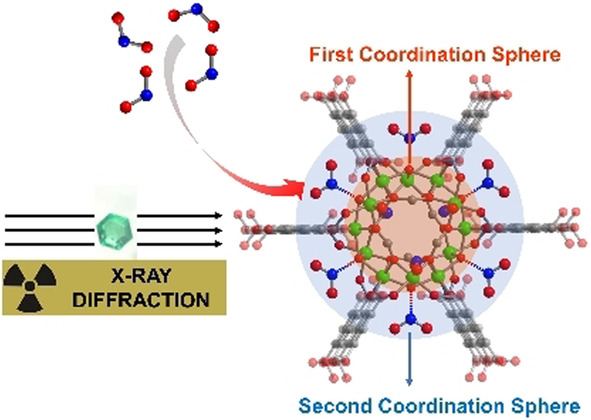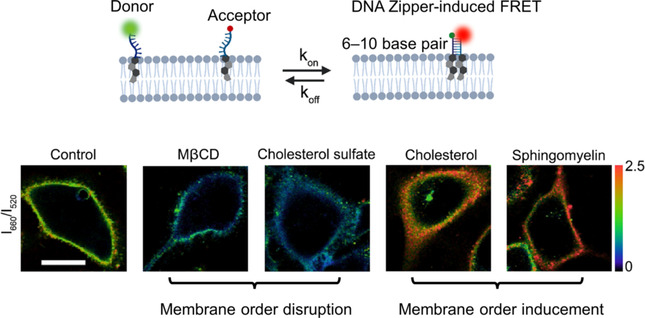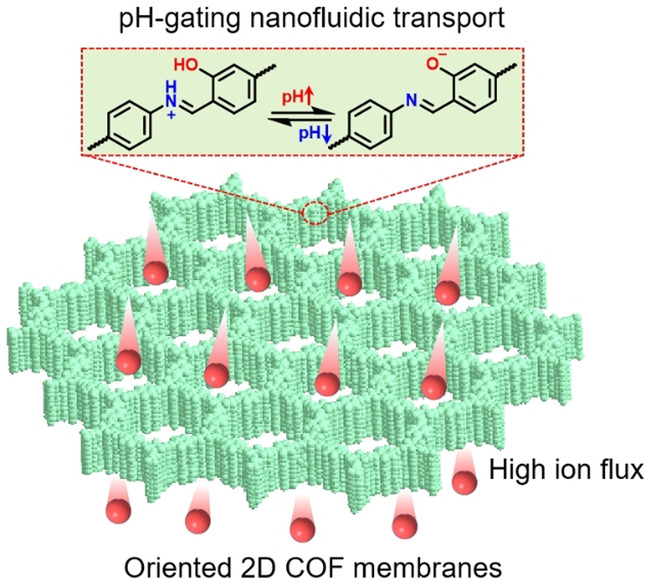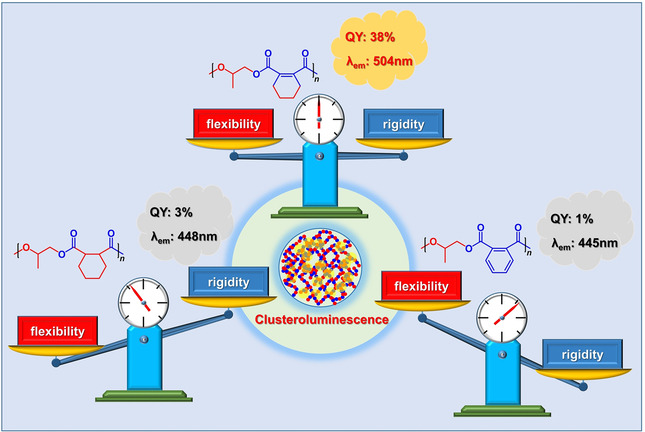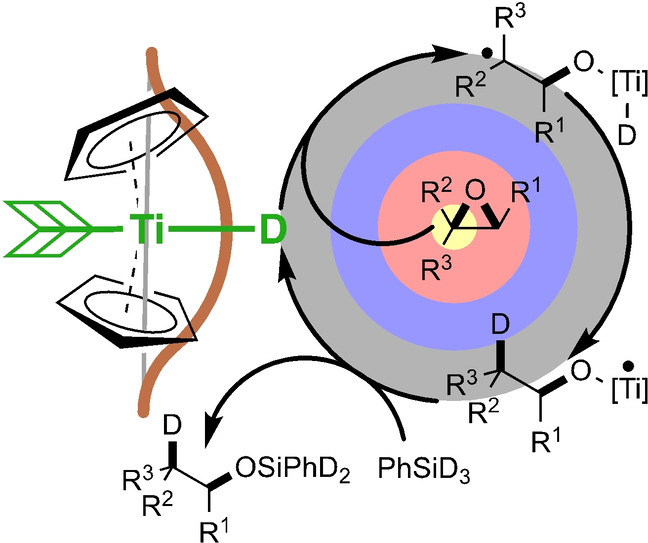Journal list menu
Export Citations
Download PDFs
Titelbild
Titelbild: A {Ni12}-Wheel-Based Metal–Organic Framework for Coordinative Binding of Sulphur Dioxide and Nitrogen Dioxide (Angew. Chem. 6/2022)
- First Published: 18 January 2022
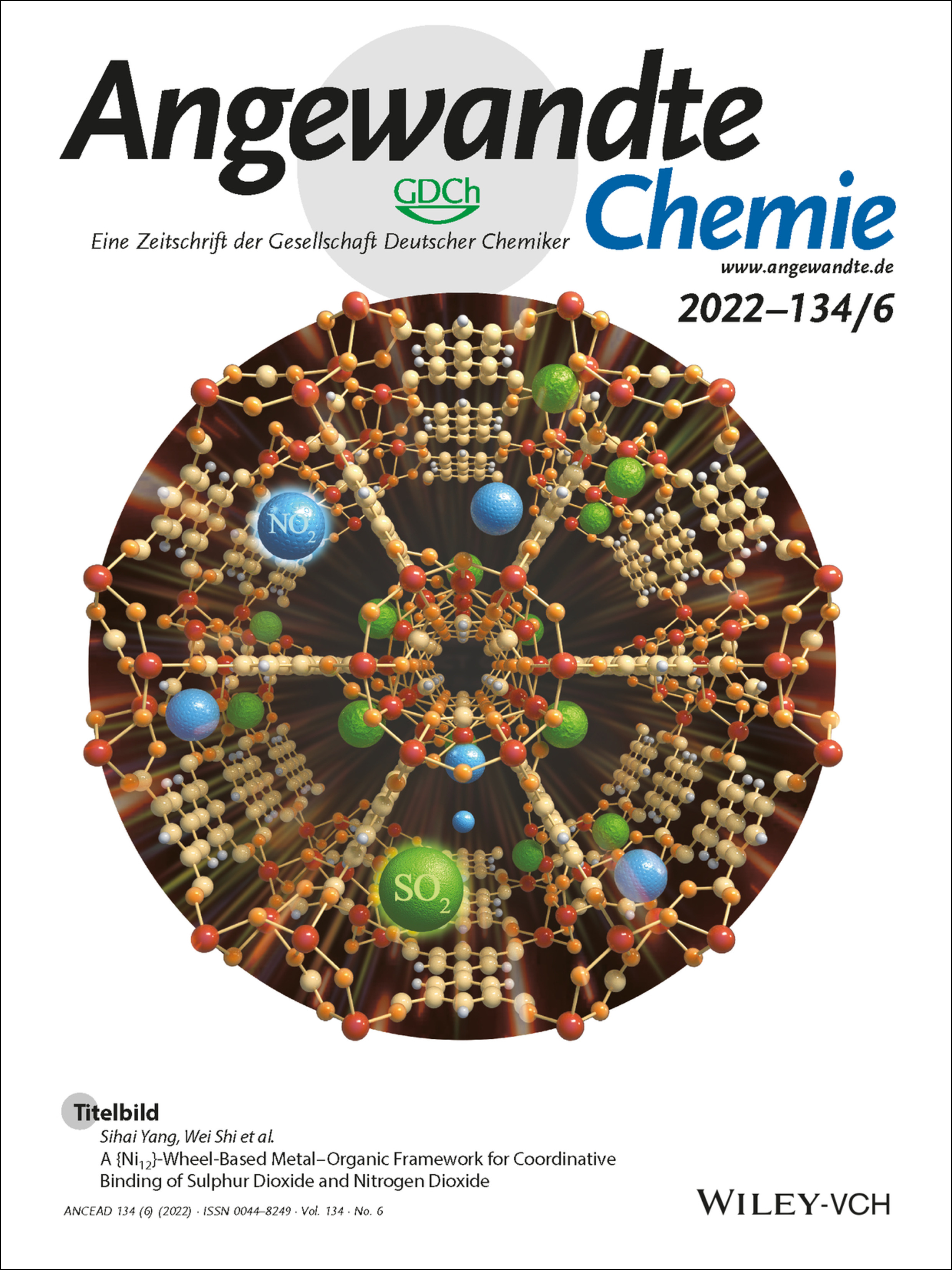
SO2 und NO2 sind wichtige Luftschadstoffe, und das mechanistische Verständnis von Abscheidematerialien treibt die Entwicklung neuer Reinigungstechnologien voran. In-situ-Synchrotron-Röntgenkristallographie- und Spektroskopieexperimente lieferten einen detaillierten molekularen Mechanismus, bestehend aus der reversiblen Koordination von SO2 und NO2 an den sechs offenen Ni(II)-Stellen auf dem {Ni12}-Zyklus eines robusten metallorganischen Gerüstmaterials (NKU-100), wie Sihai Yang, Wei Shi et al. in ihrem Forschungsartikel berichten (e202115585).
Innentitelbild: Dianion and Dication of Tetracyclopentatetraphenylene as Decoupled Annulene-within-an-Annulene Models (Angew. Chem. 6/2022)
- First Published: 18 January 2022
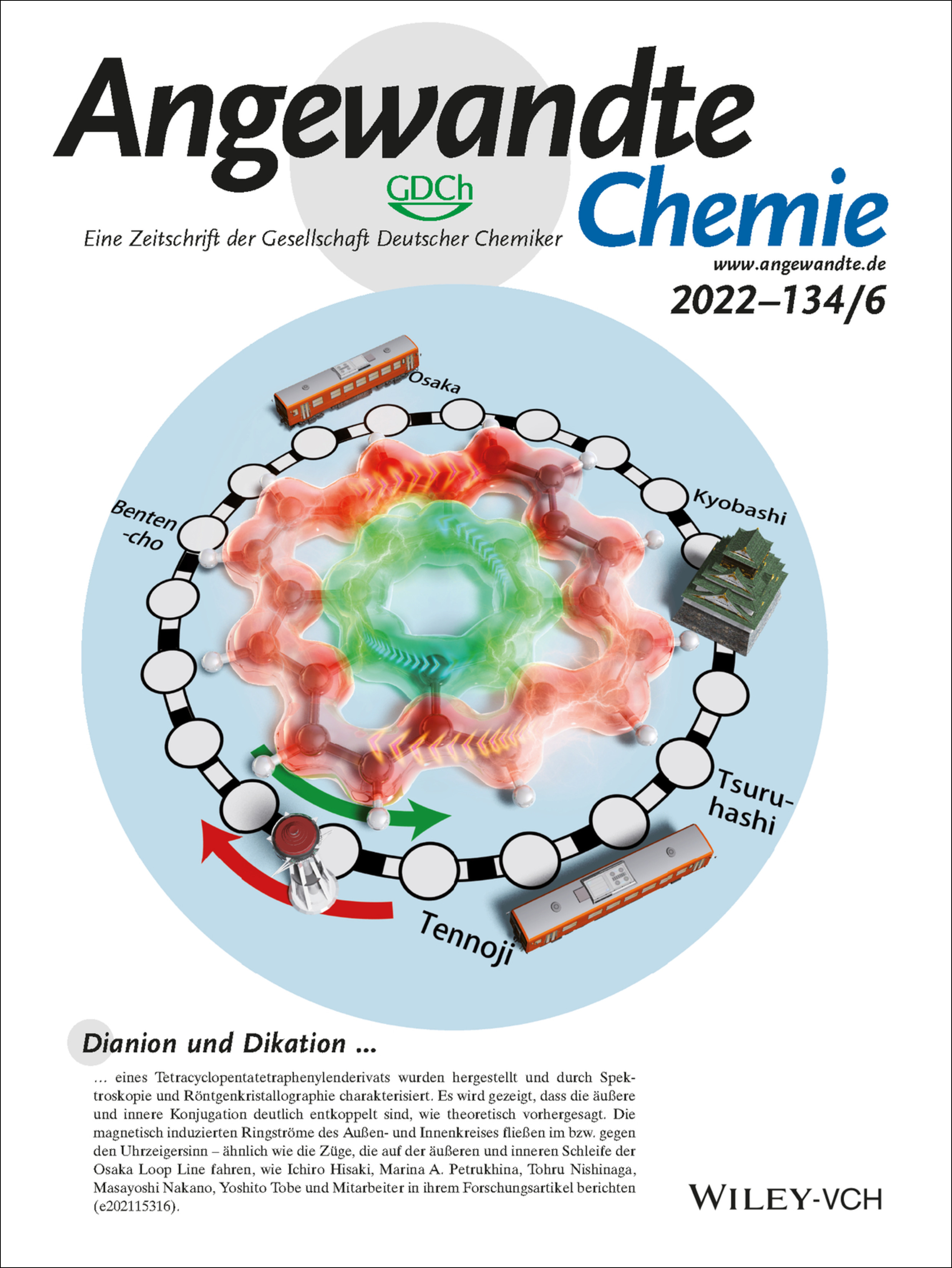
Dianion und Dikation eines Tetracyclopentatetraphenylenderivats wurden hergestellt und durch Spektroskopie und Röntgenkristallographie charakterisiert. Es wird gezeigt, dass die äußere und innere Konjugation deutlich entkoppelt sind, wie theoretisch vorhergesagt. Die magnetisch induzierten Ringströme des Außen- und Innenkreises fließen im bzw. gegen den Uhrzeigersinn – ähnlich wie die Züge, die auf der äußeren und inneren Schleife der Osaka Loop Line fahren, wie Ichiro Hisaki, Marina A. Petrukhina, Tohru Nishinaga, Masayoshi Nakano, Yoshito Tobe und Mitarbeiter in ihrem Forschungsartikel berichten (e202115316).
Innenrücktitelbild: Atomic Bridging Structure of Nickel–Nitrogen–Carbon for Highly Efficient Electrocatalytic Reduction of CO2 (Angew. Chem. 6/2022)
- First Published: 18 January 2022
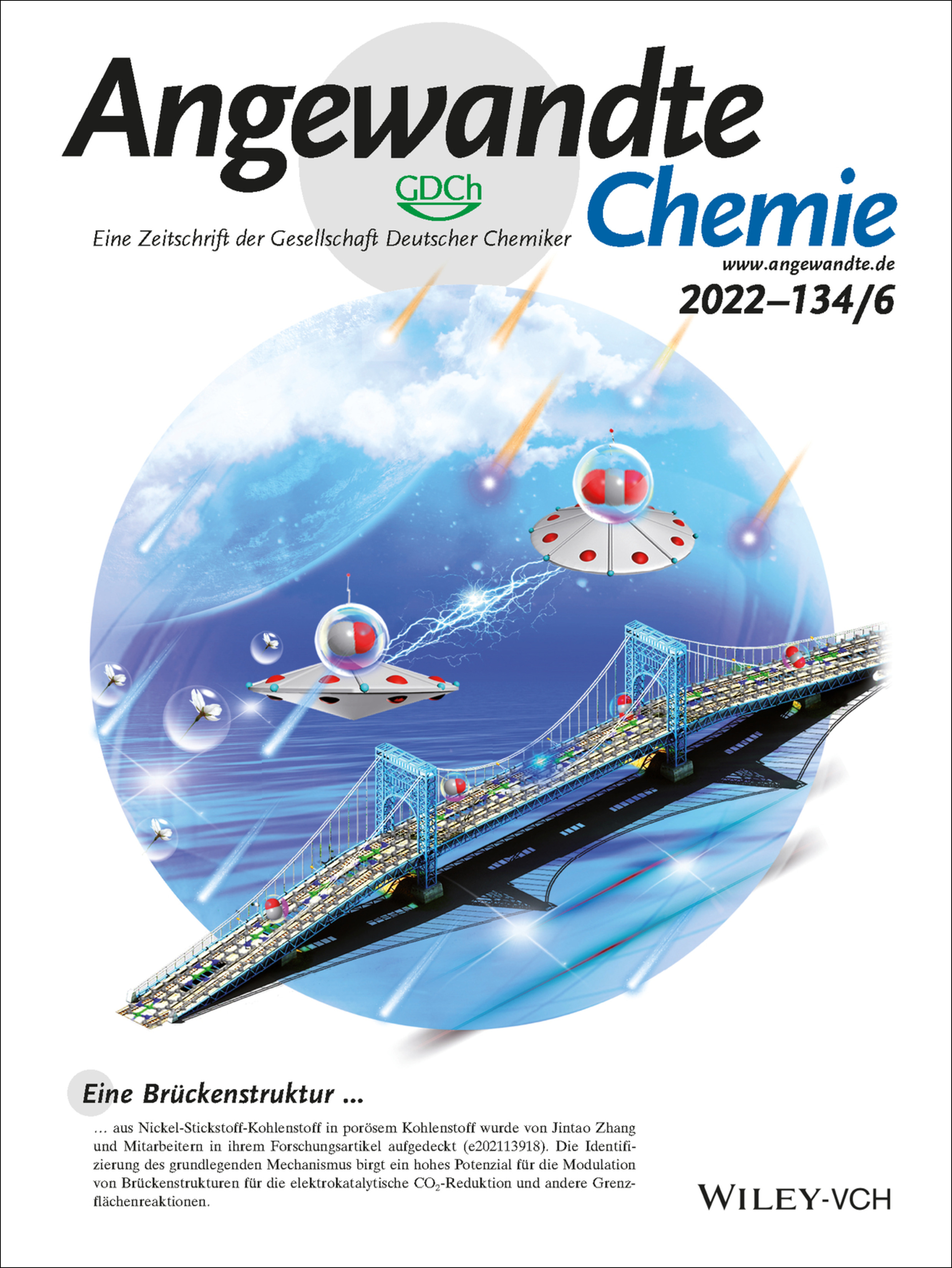
Eine Brückenstruktur aus Nickel-Stickstoff-Kohlenstoff in porösem Kohlenstoff wurde von Jintao Zhang und Mitarbeitern in ihrem Forschungsartikel aufgedeckt (e202113918). Die Identifizierung des grundlegenden Mechanismus birgt ein hohes Potenzial für die Modulation von Brückenstrukturen für die elektrokatalytische CO2-Reduktion und andere Grenzflächenreaktionen.
Rücktitelbild: PDMS with Tunable Side Group Mobility and Its Highly Permeable Membrane for Removal of Aromatic Compounds (Angew. Chem. 6/2022)
- First Published: 12 January 2022

Aromatenpermeable Membranen aus Polydimethylsiloxan mit abstimmbaren Seitengruppenmobilitäten werden im Forschungsartikel von Gongping Liu und Mitarbeitern vorgestellt (e202111810). Phenylgruppen wurden als starre molekulare Abstandhalter eingeführt, um dem Methyl eine hohe Mobilität zu verleihen und die Polymerkonformation zu rekonstruieren, wodurch Bahnen für den schnellen Transport von Aromatenmolekülen geschaffen werden, die eine effiziente Entfernung von aromatischen Verbindungen aus wässriger Lösung ermöglichen.
Frontispiz
Frontispiz: Electrochemical Desaturative β-Acylation of Cyclic N-Aryl Amines
- First Published: 25 January 2022
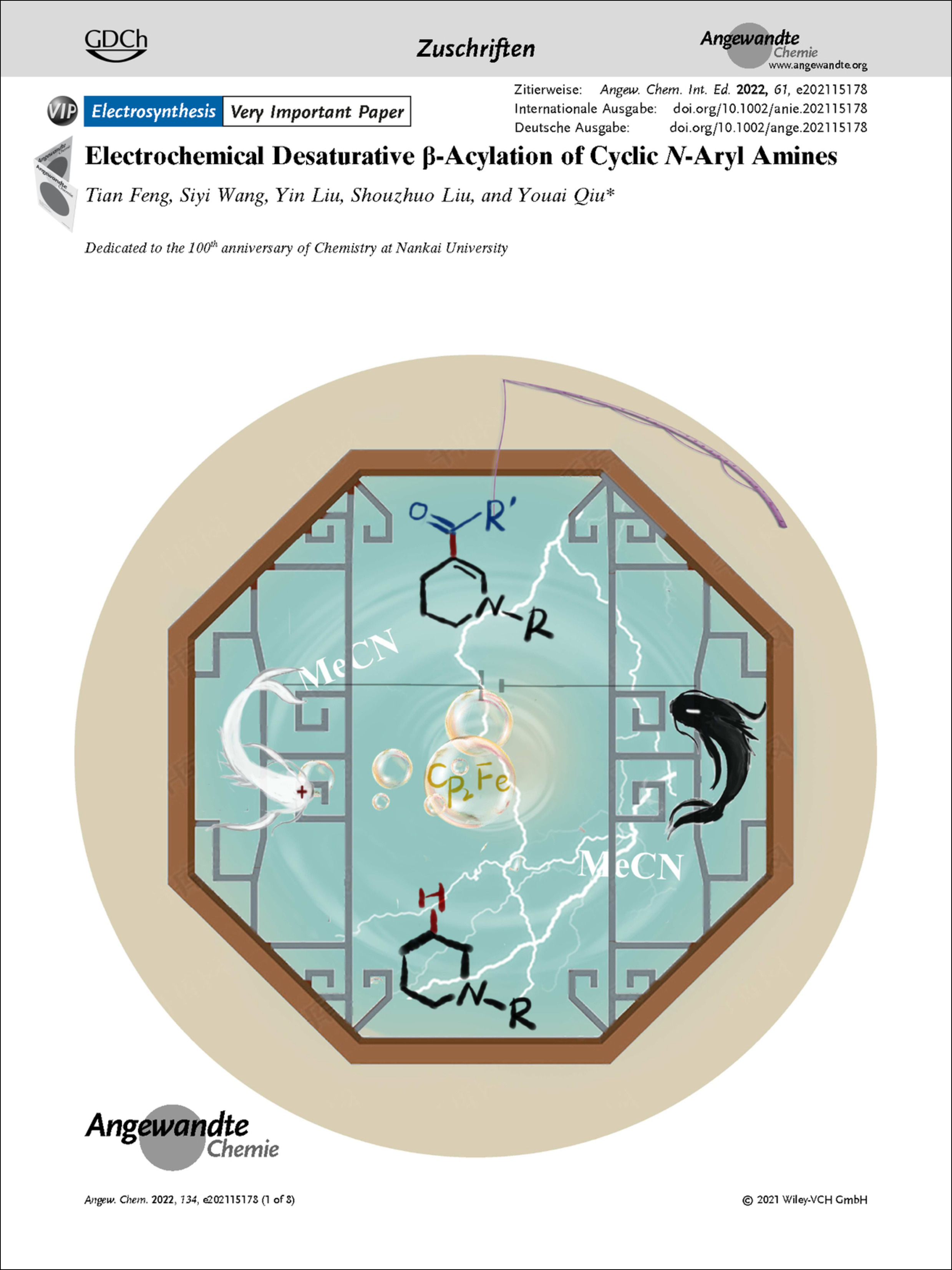
Elektrochemie. Die elektrochemische desaturierende α-Acylierung von cyclischen N-Arylaminen zu α-substituierten Enaminen wird in der Zuschrift von Youai Qiu et al. vorgestellt (e202115178).
Frontispiz: Watching Microwave-Induced Microscopic Hot Spots via the Thermosensitive Fluorescence of Europium/Terbium Mixed-Metal Organic Complexes
- First Published: 25 January 2022
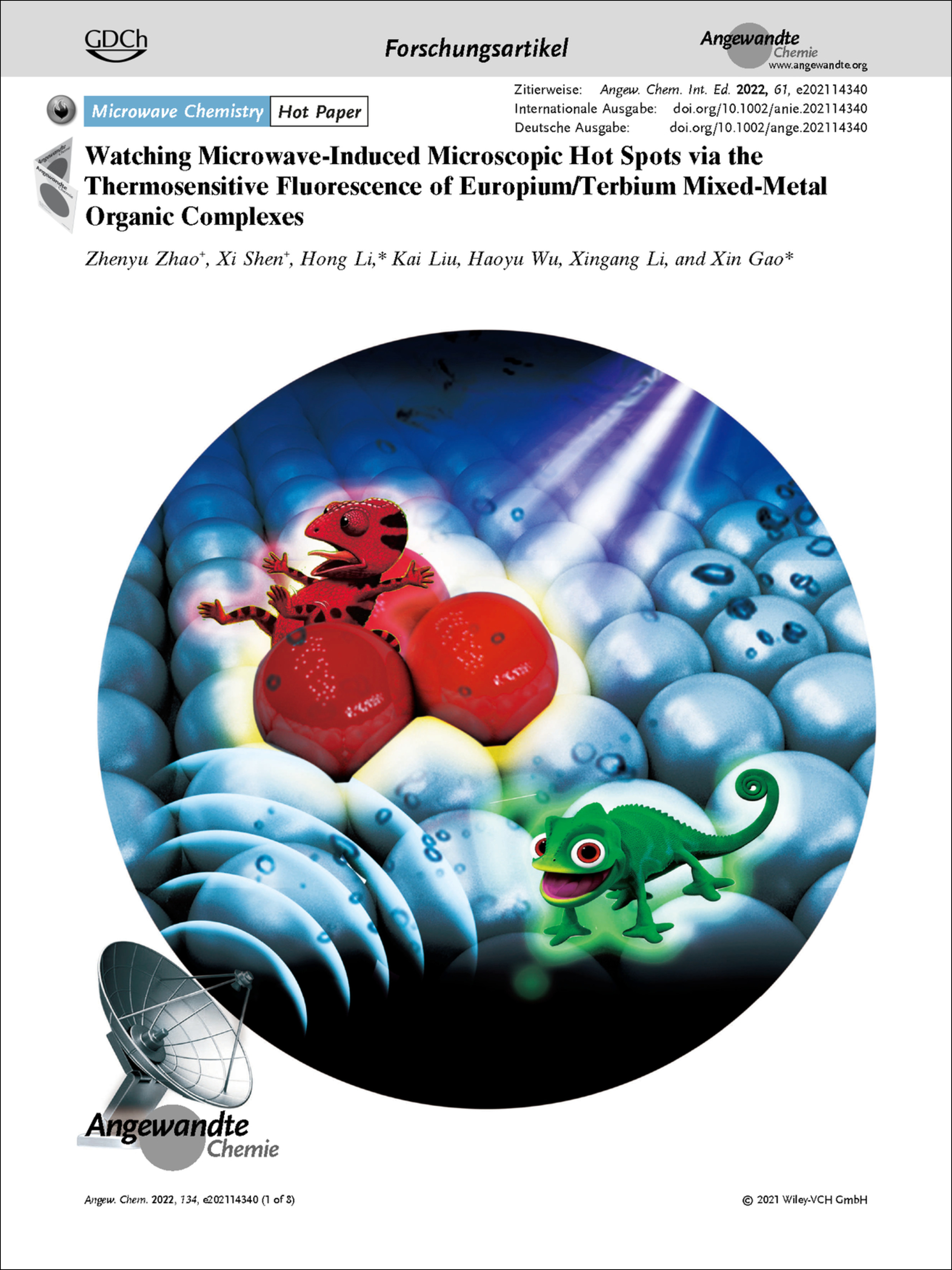
Mikrowellenchemie. In ihrem Forschungsartikel (e202114340) berichten Hong Li, Xin Gao et al. über den Nachweis von mikrowelleninduzierten Hot Spots in flüssigen Lösungen mithilfe eines Fluoreszenzthermometers, das an mikrowellenabsorbierenden Kohlenstoffpartikeln angebracht ist.
Graphisches Inhaltsverzeichnis
Graphisches Inhaltsverzeichnis: Angew. Chem. 6/2022
- First Published: 25 January 2022
Berichtigung
Introducing …
Kurzaufsätze
C(sp3)-H Activation
Transition-Metal-Catalyzed Annulations Involving the Activation of C(sp3)−H Bonds
- First Published: 26 October 2021
Aufsätze
Piezocatalysis
The Mechanism of Piezocatalysis: Energy Band Theory or Screening Charge Effect?
- First Published: 06 October 2021
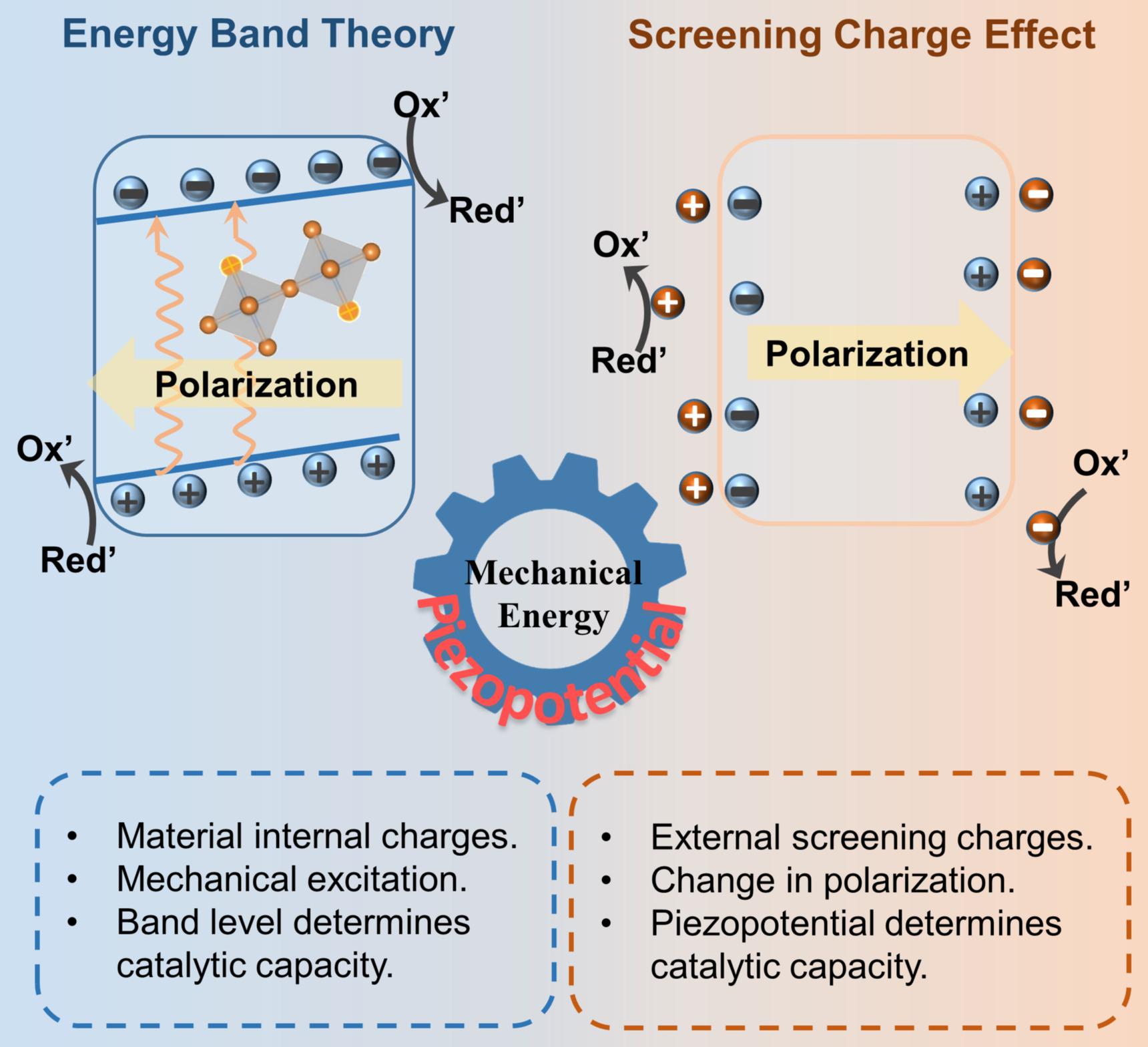
This review summarizes advances in the mechanistic study of newly developed piezocatalysis systems. The differences, relevance, evidence, and contradiction of the tentative mechanisms of energy band theory and screening charge effect are elaborated. The current challenges and perspectives for future mechanistic studies are provided.
Molecular Crystals
Quantifying Mechanical Properties of Molecular Crystals: A Critical Overview of Experimental Elastic Tensors
- First Published: 18 October 2021

An extensive overview of experimental elastic constant tensors for molecular crystals employs a rotation-invariant description of the Young's modulus to critically compare multiple observations and computational results. To encourage the wider use of experimental elastic constant tensors in studies of mechanical properties, outliers are clearly identified, resulting in a curated database of experimental results for molecular crystals.
Zuschriften
Electrosynthesis | Very Important Paper
Electrochemical Desaturative β-Acylation of Cyclic N-Aryl Amines
- First Published: 08 December 2021
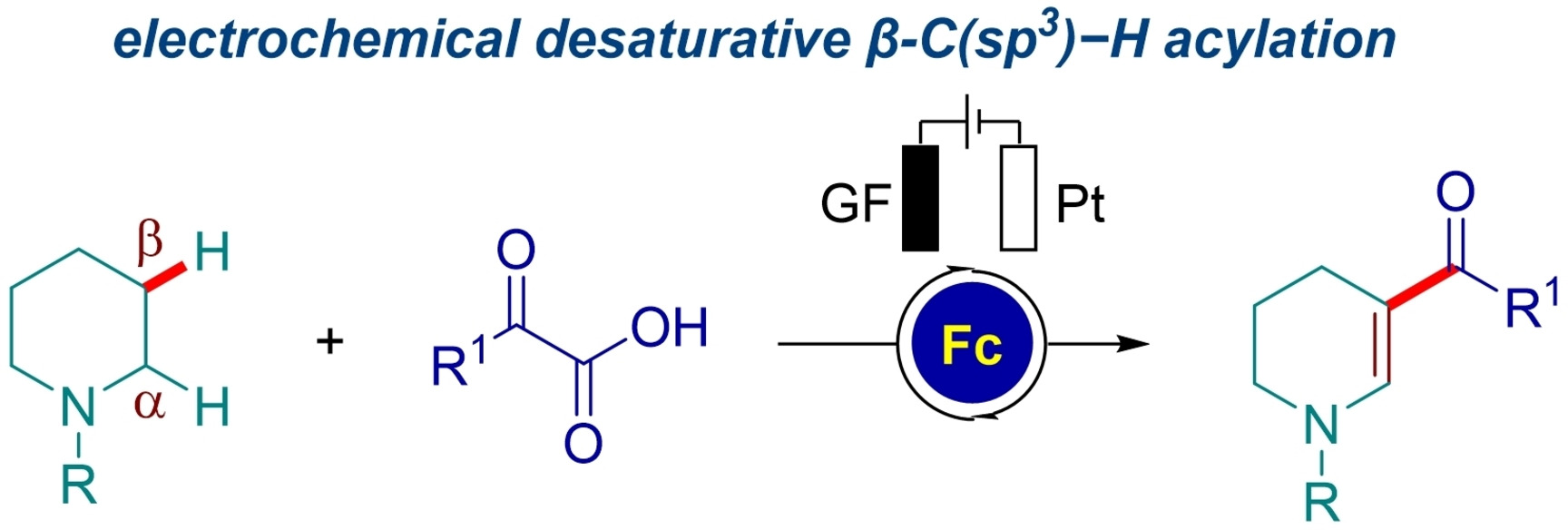
A straightforward and simple method of electrochemical desaturative β-C(sp3)−H acylation of cyclic N-aryl amines has been developed to access the desired β-substituted enamines with excellent levels of chemo- and regioselectivity under mild conditions. This procedure proved to be a powerful route to the late-stage modification of natural products and derivatives.
Electroanalytical Chemistry
Detection of Bacterial Rhamnolipid Toxin by Redox Liposome Single Impact Electrochemistry
- First Published: 23 November 2021
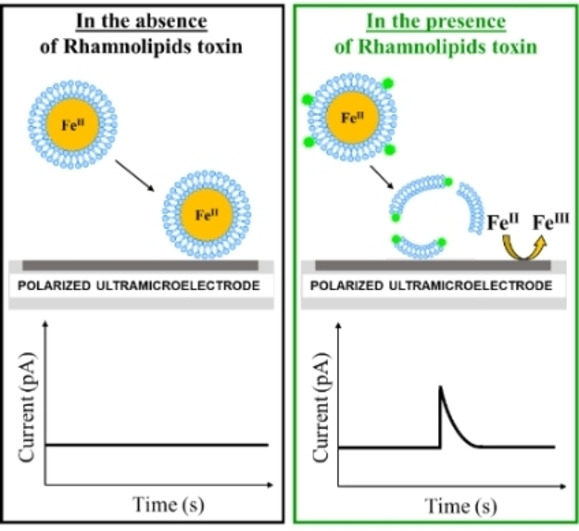
A proof-of-concept is reported that the electrochemistry of redox liposome single impacts is a powerful and efficient analytical technique for sensing target toxins produced by pathogenic bacteria such as Rhamnolipid from Pseudomonas aeruginosa which interacts destructively with the lipid membrane of liposomes. A high sensitivity of sensing has been reached with a submicromolar concentration of Rhamnolipid detected in less than 30 minutes.
Asymmetric Synthesis
Nickel-Catalyzed Stereo- and Enantioselective Cross-Coupling of gem-Difluoroalkenes with Carbon Electrophiles by C−F Bond Activation
- First Published: 10 December 2021
OLEDs | Hot Paper
Highly Efficient Light-Emitting Diodes Based on an Organic Antimony(III) Halide Hybrid
- First Published: 15 November 2021
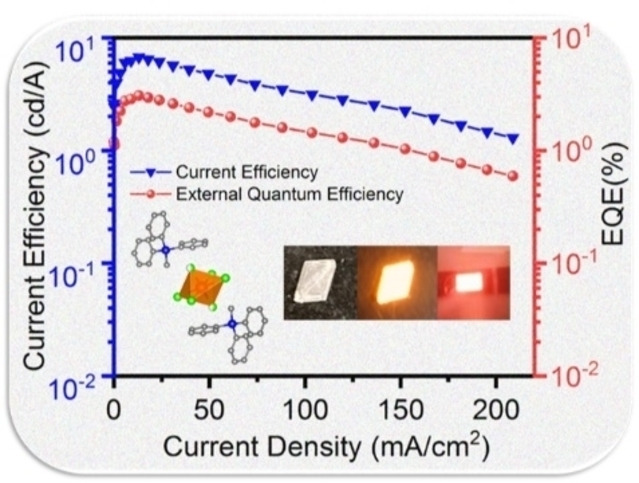
A highly luminescent organic antimony(III) hybrid (MePPh3)2SbCl5 featured with STE emission is prepared with good reproducibility and high stability. High-efficiency OLEDs are demonstrated by this hybrid as an emitter with the luminance of 3500 cd m−2, current efficiency of 6.8 cd A−1 and EQE of 3.1 %, respectively.
Peptide Biosynthesis
Biosynthesis of Gut-Microbiota-Derived Lantibiotics Reveals a Subgroup of S8 Family Proteases for Class III Leader Removal
- First Published: 10 December 2021
Helicenes
Enantioselective Synthesis of Dithia[5]helicenes and their Postsynthetic Functionalization to Access Dithia[9]helicenes
- First Published: 07 December 2021
![Enantioselective Synthesis of Dithia[5]helicenes and their Postsynthetic Functionalization to Access Dithia[9]helicenes](/cms/asset/87e2602d-0696-4921-a216-2fa3b2d6cc97/ange202114577-toc-0001-m.jpg)
The use of a chiral Au catalyst bearing an α-cationic phosphonite as an ancillary ligand and two successive alkyne hydroarylation events allows the assembly of dithia[5]helicenes with excellent enantioselectivity. Moreover, regioselective postsynthetic bromination of the dithia[5]helicene products generates starting materials for the efficient preparation of even more π-expanded systems, such as dithia[9]helicenes.
Trifluoromethylation
Catalytic Asymmetric Homologation of 4-Substituted Cyclohexanones with CF3CHN2: Enantioselective Synthesis of α-Trifluoromethyl Cycloheptanones
- First Published: 13 December 2021

α-Trifluoromethyl cycloheptanones containing the C(sp3)−CF3 bond on the chiral centers were accessed through a highly stereoselective ScIII/chiral bisoxazoline-catalyzed homologation reaction of cyclic ketones with CF3CHN2 as the trifluoromethylation reagent. This reaction could be applied to construct silicon-stereogenic centers with moderate diastereoselectivities and high enantioselectivities.
Protein Modification | Hot Paper
Site-Specific Conjugation of a Selenopolypeptide to Alpha-1-antitrypsin Enhances Oxidation Resistance and Pharmacological Properties
- First Published: 12 December 2021
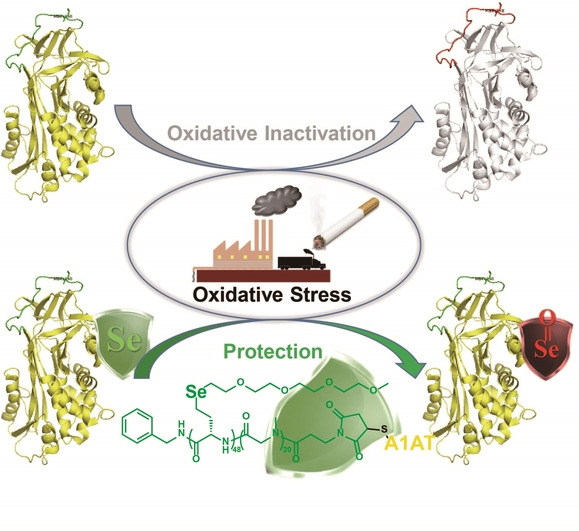
A novel biocompatible selenopolypeptide was site-specifically conjugated to alpha-1-antitrypsin (A1AT). The conjugated A1AT fully retained its inhibitory activity on neutrophil elastase (NE), enhanced oxidation resistance, extended the serum half-life, and afforded long-lasting protective activity in a mouse model of acute lung injury.
Sigmatropic Rearrangements | Hot Paper
Expeditious and Efficient ortho-Selective Trifluoromethane-sulfonylation of Arylhydroxylamines
- First Published: 13 December 2021
Nonlinear Optical Materials | Hot Paper
A Lanthanum Ammonium Sulfate Double Salt with a Strong SHG Response and Wide Deep-UV Transparency
- First Published: 11 December 2021
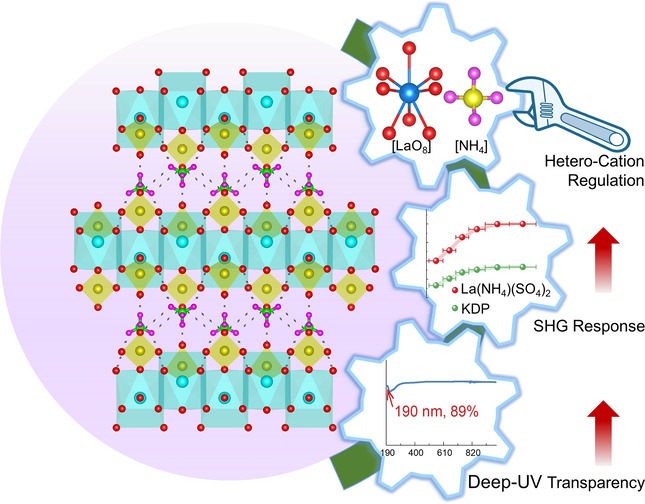
The first rare-earth metal-based deep-UV sulfate La(NH4)(SO4)2, which exhibits a short-wavelength deep-UV absorption edge (below 190 nm) and the strongest SHG response among deep-UV NLO sulfates (2.4×KDP), has been successfully synthesized by a double-salt strategy involving introduction of complementary cations.
NMR Spectroscopy | Hot Paper
Characterization of Mannosyl Dioxanium Ions in Solution Using Chemical Exchange Saturation Transfer NMR Spectroscopy
- First Published: 14 September 2021
Forschungsartikel
Microwave Chemistry | Hot Paper
Watching Microwave-Induced Microscopic Hot Spots via the Thermosensitive Fluorescence of Europium/Terbium Mixed-Metal Organic Complexes
- First Published: 05 December 2021
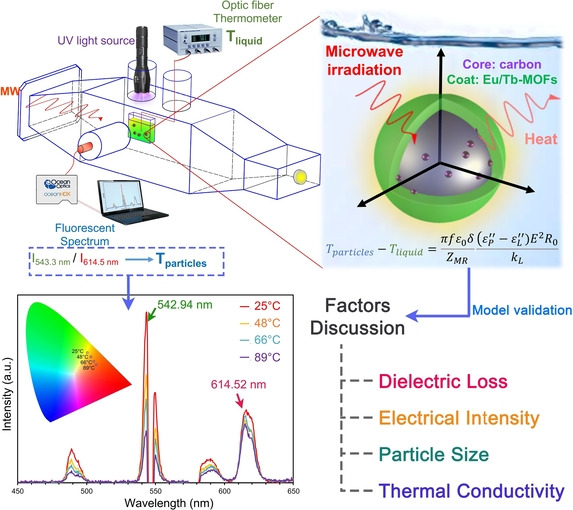
Microwave-induced micro-hot spots were detected in liquid solutions through fluorescence thermometers attached on microwave-absorbing carbon particles. The fluorescent experiments confirmed the established microwave-irradiated energy-transfer model, whose results can guide precise control and optimization of conditions in microwave chemistry.
Polymerization | Hot Paper
A Ni0 σ-Borane Complex Bearing a Rigid Bidentate Borane/Phosphine Ligand: Boryl Complex Formation by Oxidative Dehydrochloroborylation and Catalytic Activity for Ethylene Polymerization
- First Published: 01 December 2021

The synthesis of a rigid bidentate borane/phosphine ligand was explored within the background of statistical olefin copolymerization with group 10 metals. During this work, a mild oxidative dehydrochloroborylation reaction was found to convert different Ni0 σ-borane complexes into NiII boryl chloride complexes. This new ligand also allows the nickel catalyzed polymerization of ethylene, a first for a B-donor in group 10 olefin polymerization.
Membranes | Hot Paper
PDMS with Tunable Side Group Mobility and Its Highly Permeable Membrane for Removal of Aromatic Compounds
- First Published: 01 December 2021
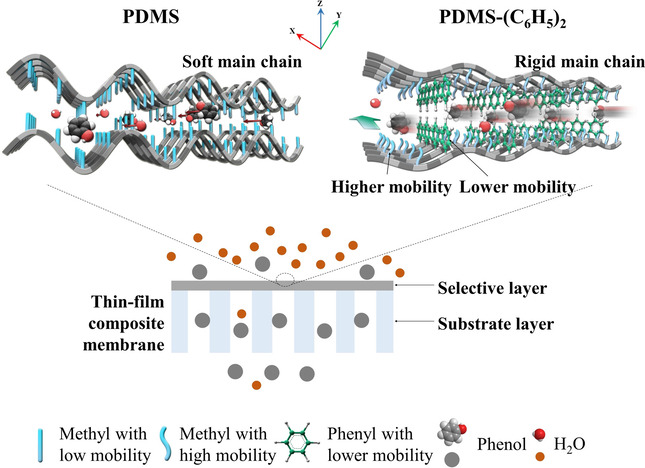
The introduction of phenyl side groups as rigid molecular spacers into polydimethylsiloxane (PDMS) imparted the methyl side groups with higher mobility and additional degrees of freedom for fast transport of aromatic compounds. Combined with the engineering design of the transport highway, the membrane achieved outstanding performance for aromatic removal.
CO2 Reduction | Hot Paper
Atomic Bridging Structure of Nickel–Nitrogen–Carbon for Highly Efficient Electrocatalytic Reduction of CO2
- First Published: 14 December 2021
MOF-Based Superstructures
Low-Symmetry MOF-Based Patchy Colloids and Their Precise Linking via Site-Selective Liquid Bridging to Form Supra-Colloidal and Supra-Framework Architectures
- First Published: 09 December 2021
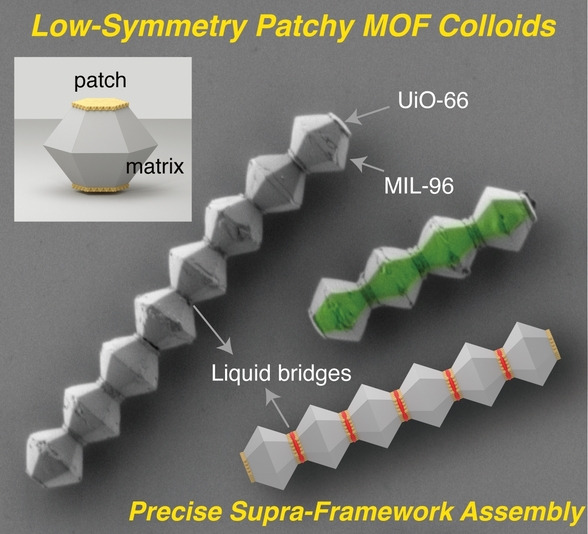
Low-symmetry, MOF-based patchy colloids are reported, which carry both shape and chemical information that enables precise directional colloidal assembly, producing hierarchical, multicomponent, and supra-framework architectures with unprecedented control over the position, rotation, and orientation of the constituent building blocks.
Room-Temperature Phosphorescence
Tunable Second-Level Room-Temperature Phosphorescence of Solid Supramolecules between Acrylamide–Phenylpyridium Copolymers and Cucurbit[7]uril
- First Published: 07 December 2021
![Tunable Second-Level Room-Temperature Phosphorescence of Solid Supramolecules between Acrylamide–Phenylpyridium Copolymers and Cucurbit[7]uril](/cms/asset/8eaa50eb-27f0-4eb7-9a71-321f2712320a/ange202115265-toc-0001-m.jpg)
Solid supramolecules based on acrylamide–phenylpyridium copolymers with various substituent groups and cucurbit[7]uril not only exhibit tunable ultralong phosphorescence with lifetimes varying from 0.9 s to 2.2 s, but also co-assemble with organic dyes Eosin Y or SR101 to display high-performance phosphorescence energy transfer with multicolor delayed fluorescence properties.
Annulenes | Very Important Paper
Dianion and Dication of Tetracyclopentatetraphenylene as Decoupled Annulene-within-an-Annulene Models
- First Published: 06 December 2021
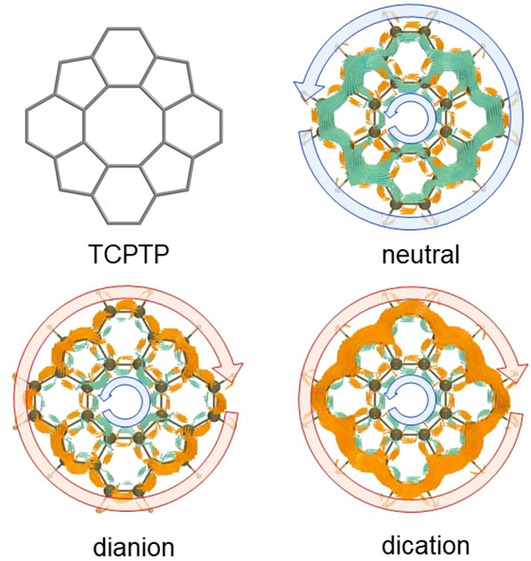
Dianion and dication of a tetracyclopentatetraphenylene derivative were generated and investigated as the annulene-within-an-annulene models. Experiments based on X-ray crystallography and 1H NMR, 13C NMR, and MCD spectroscopies indicate that the outer and inner conjugation circuits are significantly decoupled, strongly supporting the theoretically predicted structures.
CO2 Reduction
Metallization-Prompted Robust Porphyrin-Based Hydrogen-Bonded Organic Frameworks for Photocatalytic CO2 Reduction
- First Published: 07 December 2021
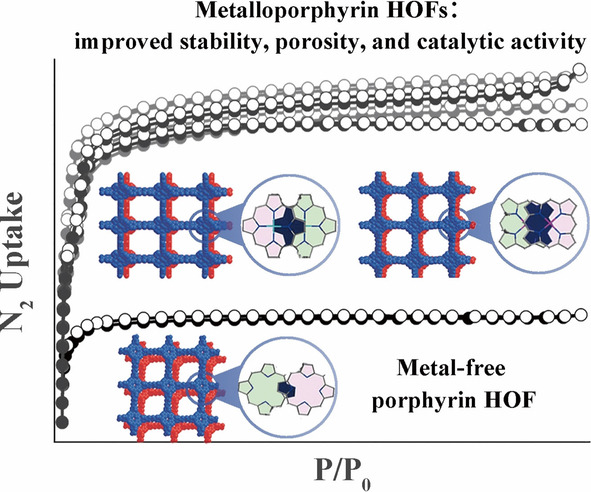
Crystallographic and computational studies on a series of porphyrinic hydrogen-bonded organic frameworks (HOFs) reveal that metallization of porphyrin centers greatly alters the orbital overlap of the adjacent porphyrin, the geometry of the molecule/layer, and the strength of noncovalent interactions. Therefore, metalloporphyrin HOFs exhibit much higher stability, surface area, and catalytic activity than metal-free porphyrinic HOFs.
Electrocatalysis | Very Important Paper
Scalable Molten Salt Synthesis of Platinum Alloys Planted in Metal–Nitrogen–Graphene for Efficient Oxygen Reduction
- First Published: 10 December 2021
MOFs | Hot Paper
A {Ni12}-Wheel-Based Metal–Organic Framework for Coordinative Binding of Sulphur Dioxide and Nitrogen Dioxide
- First Published: 29 November 2021
Biosensors
Circular Permutated PQQ-Glucose Dehydrogenase as an Ultrasensitive Electrochemical Biosensor
- First Published: 11 October 2021
Supramolecular Chemistry
Assembly of Hexagonal Column Interpenetrated Spheres from Plant Polyphenol/Cationic Surfactants and Their Application as Antimicrobial Molecular Banks
- First Published: 17 November 2021

Long-lasting and broad-spectrum antimicrobial agents with the special structure of hexagonal column interpenetrated spheres (HCISs) are constructed through non-covalent assembly of plant gallic acid and quaternary ammonium surfactants. HCISs possess high substrate-adhesion on various substrates and high anti-water washing property, and can continuously provide antimicrobial ingredients in a multistage way, avoiding one-time burst release of antimicrobial units.
Covalent Organic Frameworks
Heteroatom-Embedded Approach to Vinylene-Linked Covalent Organic Frameworks with Isoelectronic Structures for Photoredox Catalysis
- First Published: 23 November 2021
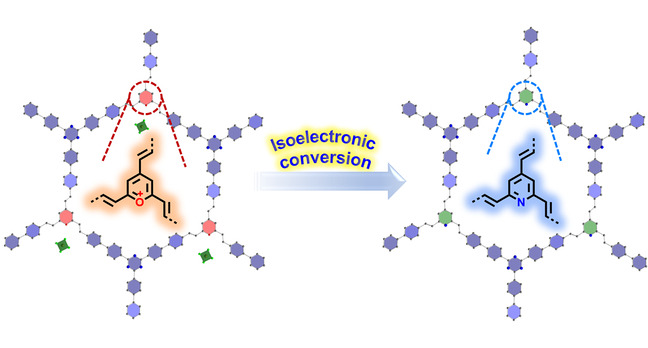
A two-dimensional oxonium-embedded COF with vinylene linkages was synthesized by condensation of a trimethyl-substituted pyrylium with a tritopic aromatic aldehyde derivative, which was readily converted to a neutral pyridine-cored COF by in situ replacing oxonium with nitrogen atoms under the treatment of ammonia.
Bioconjugation
Azaphilones as Activation-Free Primary-Amine-Specific Bioconjugation Reagents for Peptides, Proteins and Lipids
- First Published: 26 November 2021
Bioimaging | Hot Paper
Fluorescence Imaging of Mitochondrial DNA Base Excision Repair Reveals Dynamics of Oxidative Stress Responses
- First Published: 01 December 2021

A light-up fluorescent probe (UBER) that reacts rapidly with apurinic/apyrimidinic (AP) sites visualizes base excision repair (BER) of mitochondrial DNA (mtDNA) in cells. Monitoring of the mtDNA BER process in cells over time illuminated the time lag between the initiation of oxidative stress and the initial step of DNA repair, along with the effect of DNA defensive enzymes, MTH1 and OGG1.
Biochemistry
Bioorthogonal Ligation-Activated Fluorogenic FRET Dyads
- First Published: 03 December 2021
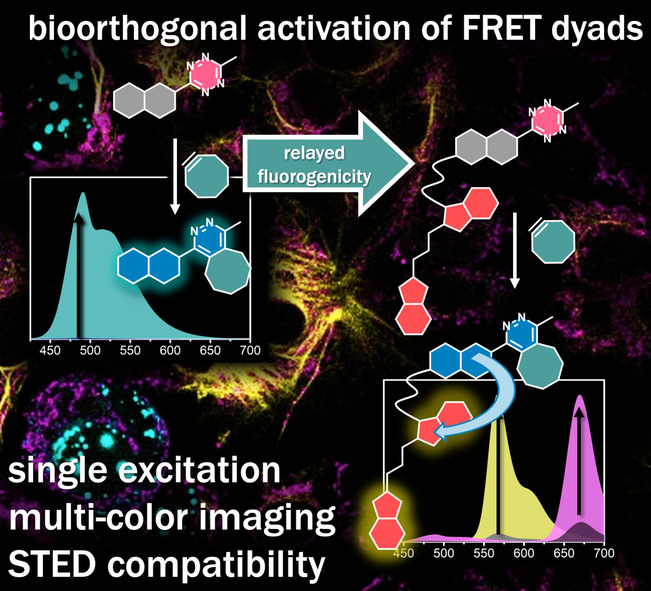
A concept for the transformation of the excellent tetrazine-ligation dependent fluorogenicity of blue-excitable cores to biologically preferable emission ranges is presented herein. Such relay mechanism resulted in improved yellow/red fluorogenicities together with increased photostabilities and large apparent Stokes-shifts. The presented fluorogenic dyads were utilized in multicolor single excitation imaging schemes and STED imaging as well.
DNA Nanotechnology
Imaging Membrane Order and Dynamic Interactions in Living Cells with a DNA Zipper Probe
- First Published: 12 November 2021
Mesocrystals
Radiation Chemistry Provides Nanoscopic Insights into the Role of Intermediate Phases in CeO2 Mesocrystal Formation
- First Published: 03 December 2021

By means of radiation chemistry, different stages of CeO2 mesocrystal formation are revealed. The nucleation and growth of the primary particles, followed by their self-assembly into mesocrystals, occur inside a hydrated CeIV hydroxide phase. The hydroxide forms as the initial phase and serves as an intermediate in the liquid-to-solid transformation. Mesocrystals can be used as buildings blocks for designing complex hierarchical structures.
Batteries | Hot Paper
Stabilizing Interface pH by N-Modified Graphdiyne for Dendrite-Free and High-Rate Aqueous Zn-Ion Batteries
- First Published: 19 November 2021

Interface pH change seriously influences dendrite formation, while its importance has not been revealed. We constructed a N-modification graphdiyne interface to stabilize pH by accelerating hydrated zinc ions desolvation, enabling the direct electron transfer from anode to Zn2+ (rather than the coordinated H2O). Operando pH detection reveals the pH stabilization. Zn-V6O13 battery works well at 20.65 mA cm−2 and 1.07 mAh cm−2. This work highlights interface pH and provides a new approach to address Zn dendrite issue.
Drug Delivery | Hot Paper
Design and Development of a Bioorthogonal, Visualizable and Mitochondria-Targeted Hydrogen Sulfide (H2S) Delivery System
- First Published: 22 November 2021
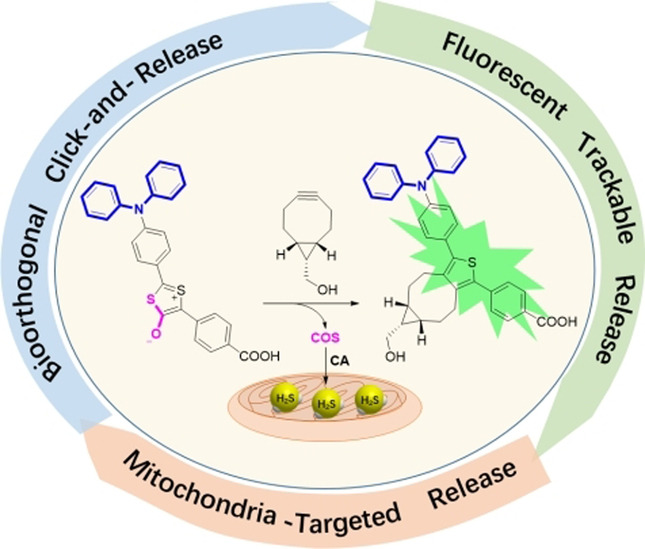
Reported herein is a triple-functional H2S delivery system, which is triggered by the bioorthogonal click-and-release reaction between a newly designed diphenylamino-substituted 1,3-dithiolium-4-olate (DTO) and a strained alkyne. This COS-based H2S release platform can realize in-mitochondria H2S release in a controllable manner, and provide a concomitant fluorescence for spatiotemporal feedback of the exogenous H2S in cells.
Photocatalysis | Hot Paper
Highly Durable and Fully Dispersed Cobalt Diatomic Site Catalysts for CO2 Photoreduction to CH4
- First Published: 08 November 2021
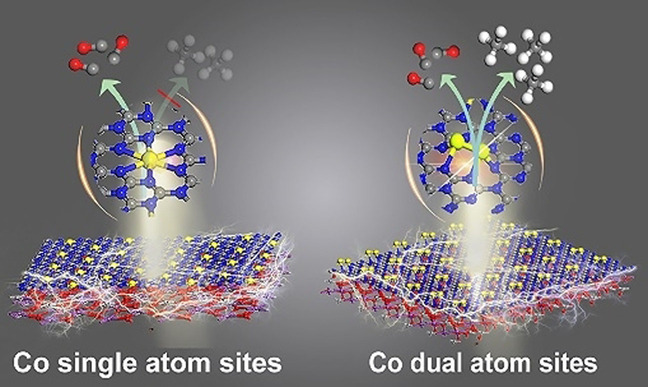
Co dual-atom catalysts were used for CO2 reduction with superior CH4 selectivity. The charge at the inserted Co2 active sites in tri-3s-triazine was enriched as compared to that at Co single sites, thus promoting a lower activation energy barrier by stabilizing the rate-limiting COOH* and CHO* intermediates.
COF Membranes | Hot Paper
Oriented Two-Dimensional Covalent Organic Framework Membranes with High Ion Flux and Smart Gating Nanofluidic Transport
- First Published: 23 November 2021
Metal-Organic Frameworks
Unraveling the Electrical and Magnetic Properties of Layered Conductive Metal-Organic Framework With Atomic Precision
- First Published: 16 November 2021
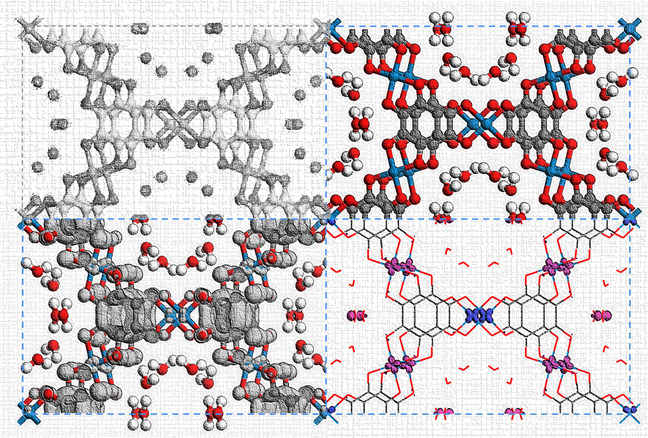
An unambiguous structural elucidation using microcrystal electron diffraction provides insight into unique properties of a layered conductive metal-organic framework (MOF) Cu3(C6O6)2. The presence of strong interlayer electronic coupling exerts a profound effect on the electrical and magnetic properties of the MOF.
DNA Nanotechnology | Hot Paper
A DNA Nanocomplex Containing Cascade DNAzymes and Promoter-Like Zn-Mn-Ferrite for Combined Gene/Chemo-dynamic Therapy
- First Published: 05 December 2021

A DNA nanocomplex containing cascade DNAzymes and promoter-like Zn-Mn-Ferrite was synthesized. The promoter-like ZMF decomposed in response to intratumoral glutathione to release a sufficient quantity of metal ions, thus promoting cascade DNA/RNA cleavage and free radical generation, and achieving combined gene/chemo-dynamic therapy.
Metal–Organic Frameworks
Bimetallic Two-Dimensional Metal–Organic Frameworks for the Chemiresistive Detection of Carbon Monoxide
- First Published: 18 November 2021
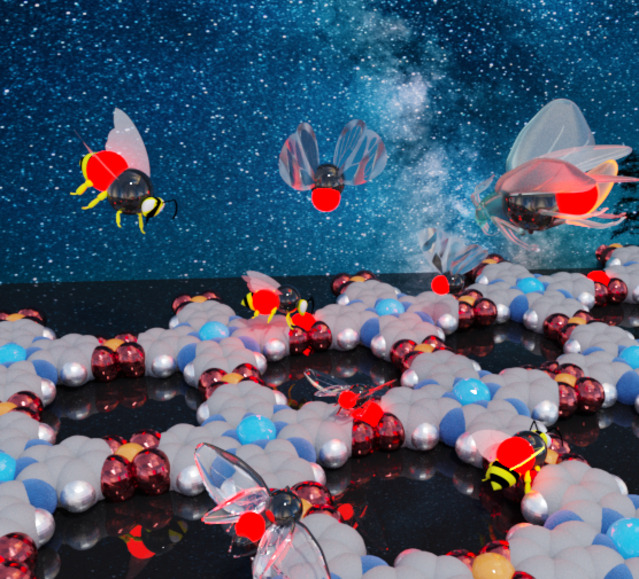
A series of isorecticular and heterobimetallic two-dimensional metal–organic frameworks achieves chemiresistive sensing of ppm concentrations of carbon monoxide at low power. Spectroscopic techniques and computational methods, along with comparative experiments, suggest the contribution of Cu nodes to CO binding and the essential role of metallophthalocyanine units in tuning and amplifying the sensing response.
Synthetic Biology
Synthetic Silica Nano-Organelles for Regulation of Cascade Reactions in Multi-Compartmentalized Systems
- First Published: 15 November 2021
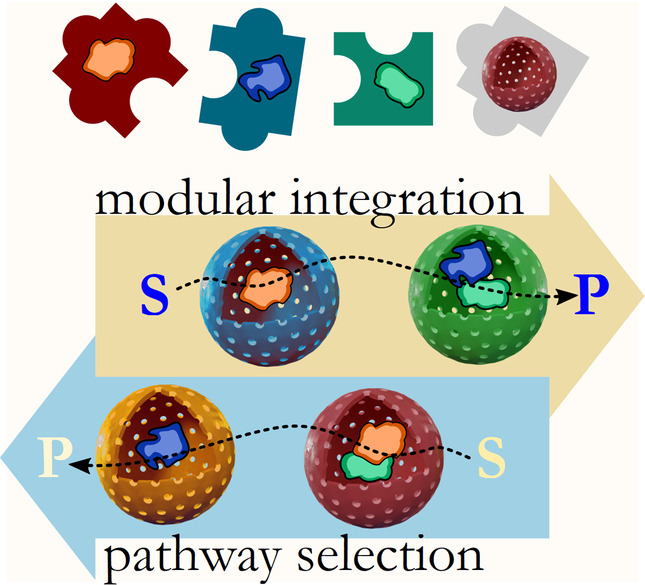
Synthetic silica nano-organelles designed to regulate kinetics and pathway selection in enzymatic cascade reactions are reported. Like cell organelles, synthetic nano-organelles can be combined to create integrated systems. Multicompartmentalized synthetic cells were built using synthetic nano-organelles and giant polymeric vesicles.
Porphyrinoids
Möbius ZnII-Hexaphyrins Bearing a Chiral Coordinating Arm: A Chiroptical Switch Featuring P/M Twist Inversion Controlled by Achiral Effectors
- First Published: 23 November 2021
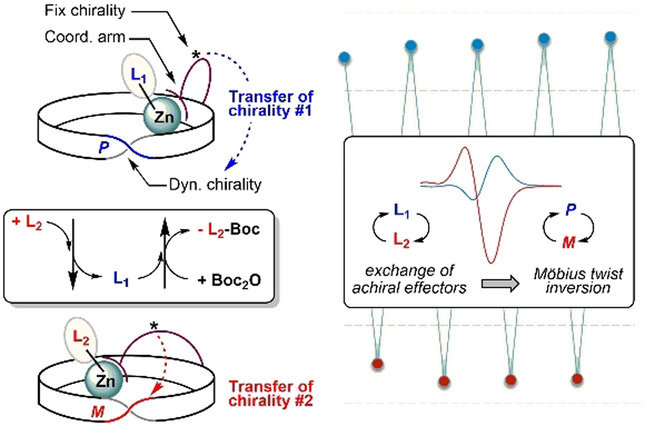
How far can the dynamic chirality of Möbius hexaphyrins be controlled lies firstly on the capacity of an attached source of chirality to explore the Möbius ring environment, which depends on several convoluted dynamic processes; secondly on the responsiveness of the system, making this exploration tunable and multi-reversible; and thirdly on the unwavering optimism of the experimenter.
Polymer Clusteroluminescence
Altering Chain Flexibility of Aliphatic Polyesters for Yellow-Green Clusteroluminescence in 38 % Quantum Yield
- First Published: 25 November 2021
Homogeneous Catalysis | Hot Paper
Titanocene(III)-Catalyzed Precision Deuteration of Epoxides
- First Published: 29 November 2021
Self-Assembly
A Supramolecular Polymer Constituted of Antiaromatic NiII Norcorroles
- First Published: 03 December 2021

A supramolecular polymer that consists of an antiaromatic π-system as the monomer has been created. An amide-functionalized NiII norcorrole derivative forms a one-dimensional supramolecular polymer through π-π stacking and hydrogen-bonding interactions. The formation of a long-range π-π-stacking array ensures the persistency of the conducting pathway against thermal perturbation and achieves high charge-carrier mobility along the tightly-bound linear aggregates.
Nitrides | Hot Paper
Single-Bonded Cubic AsN from High-Pressure and High-Temperature Chemical Reactivity of Arsenic and Nitrogen
- First Published: 19 November 2021
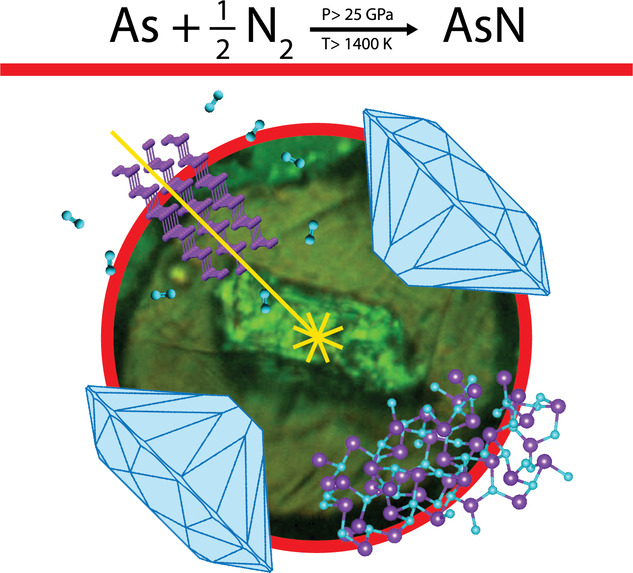
Cubic arsenic nitride was synthesized from arsenic and nitrogen under high-pressure and high-temperature conditions using a laser heated diamond anvil cell. The crystalline structure of AsN (P213), in which every As atom is single-bonded to three N atoms and vice versa, was determined by synchrotron X-ray diffraction. The discovery of AsN is relevant to the fundamental chemistry of pnictogens and to synthesis of new advanced materials.
Perovskite Solar Cells | Hot Paper
A Phenanthrocarbazole-Based Dopant-Free Hole-Transport Polymer with Noncovalent Conformational Locking for Efficient Perovskite Solar Cells
- First Published: 22 November 2021
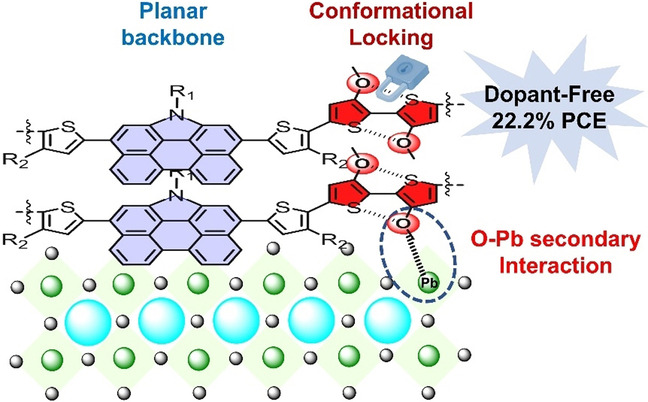
A polymeric hole-transport material (HTM) based on the phenanthrocarbazole derivative PC6 features a two-dimensionally conjugated phenanthrocarbazole and S-O noncovalent conformational locking. Perovskite solar cells employing PC6 as a dopant-free HTM afforded an excellent power conversion efficiency (PCE) of 22.2 % and long-term stability.
Solid Polymer Electrolytes | Hot Paper
SnF2-Catalyzed Formation of Polymerized Dioxolane as Solid Electrolyte and its Thermal Decomposition Behavior
- First Published: 30 November 2021
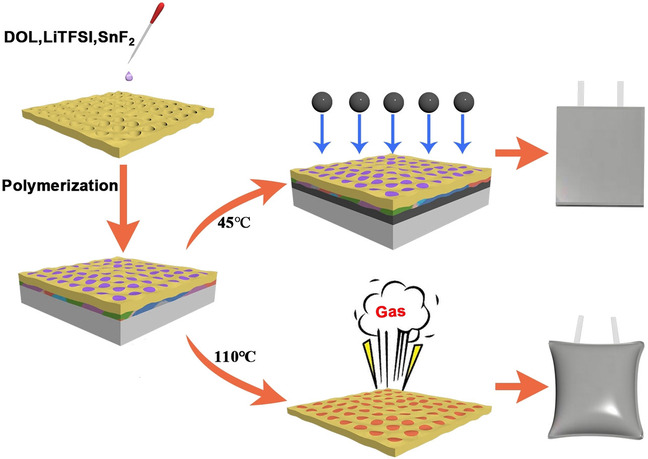
SnF2 is an efficient catalyst for the polymerization of DOL and also an effective additive for improving the interfacial wettability with Li-metal, of benefit in reaching the dendrite free and dense Li-deposition in all-solid-state cells. However, P-DOL-SPE tends to be thermally decomposed at 110 °C with the formation of formaldehyde gas and other epoxides, restricting the operating temperature window of P-DOL based electrolytes.
Supramolecular Architectures
A Hydrogen-Bonded Ravel Assembled by Anion Coordination
- First Published: 30 November 2021
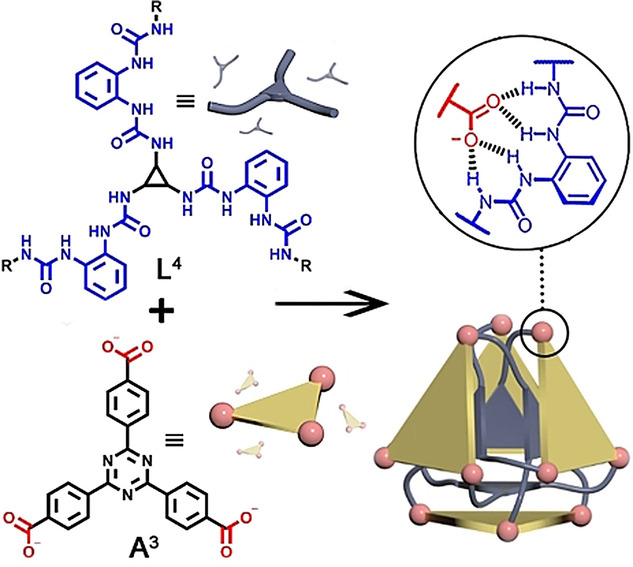
Anion-coordination-driven assembly (ACDA) between organic tris-carboxylates and tris-bis(urea) ligands afforded an Archimedean solid (truncated tetrahedron) and a double-walled tetrahedron featuring a ravel topology. The results demonstrate the promising ability of tris-carboxylates as new anion coordination centers in constructing novel topologies on account of the modifiable size and function of these organic anions.
Supramolecular Chemistry | Hot Paper
One-Pot Synthesis of Melt-Processable Supramolecular Soft Actuators
- First Published: 26 November 2021
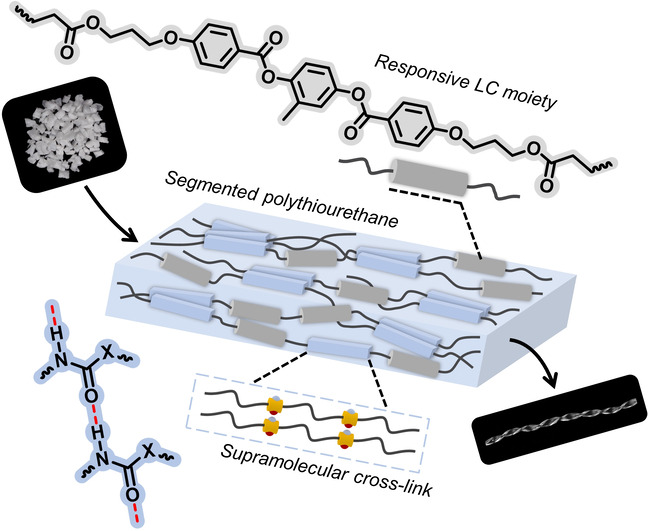
A new class of polythiourethane soft actuators based on liquid crystal and thiourethane segments has been developed by a one-pot approach. The formation of well-defined thiourethane segments affords supramolecular cross-links through hydrogen-bonding interactions yielding materials that can be reprocessed and reprogrammed into arbitrary 3D shapes. A detailed understanding and characterization of the developed material are presented.
Glycosylation | Hot Paper
Stereoselective O-Glycosylations by Pyrylium Salt Organocatalysis
- First Published: 30 November 2021
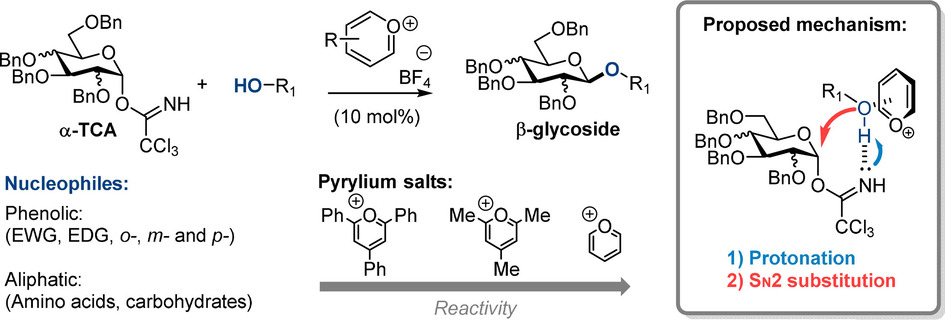
A glycosylation method for non-specialists: Commercially available pyrylium salts catalyze stereoselective glycosylation reactions with trichloroacetimidate electrophiles. A wide range of phenolic nucleophiles are compatible with the procedure. The standard conditions involve mixing three components at ambient conditions and proceed with minimal formation of undesired by-products.




